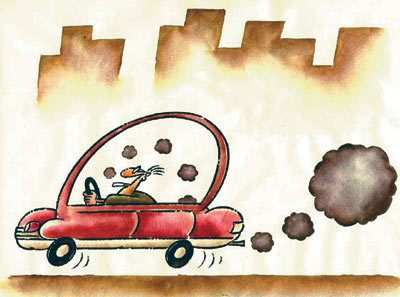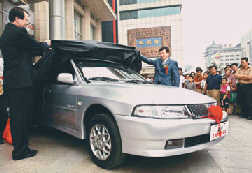Nation sets to put brakes on auto industry
( 2003-09-10 10:03) (China Daily)
The central government will soon put the brakes on the automobile industry, which has been speeding along in high gear since last year.

A new set of "Automobile Industry Development Policies", to be released shortly by the National Development and Reform Commission (NDRC), will replace existing guidelines implemented in 1994.
The new policies, according to well-informed sources, further raise the market access threshold by requiring an investment amount of at least 1.5 billion yuan (US$180.7 million) to launch a new automobile or engine manufacturing project, while a plant's registered capital must be in excess of 1 billion yuan (US$120.5 million).
Under the new guidelines, the commission "will not approve new automobile manufacturing projects in principle", the sources said, but will encourage existing producers to expand production beyond their current locations through mergers with or acquisitions of smaller players in the sector.
While pushing for restructuring and reorganization to create large-scale manufacturers, the new policies also contain articles urging auto makers to improve their research, development and technological innovation abilities.
Accordingly, the new policies will discourage assembling automobiles with imported parts by hiking import tariffs on automotive parts to the same level as those of finished cars.
Besides the higher requirements in technological development, sales and service, the new policies also contain provisions to evaluate the sources of related technology in a bid to fight piracy and encourage domestically developed manufacturing and energy-saving techniques.
Policy problems
The anticipated new central government policies, which will obviously throw cold water on the investment mania, especially dampening private and government injections, have roused divided responses from officials and experts.
The senior NDRC official stressed that China's automobile industry needs urgent structural readjustment and strategic reorganization to promote large-scale production.
He noted that, among China's 123 manufacturers of finished cars, only two have annual production rates of more than 500,000 units each, while eight produce in excess of 100,000 units, but 95 churn out fewer than 10,000 units each. And 75 of the 95 small producers record annual production numbers of just 1,000 cars a year.
While many experts agree that government investment and blind capital flooding in from SOEs must be stopped and that the new policies' aim to protect intellectual property rights is necessary, some question strengthening government approval over new automobile facilities and raising the threshold for private investors.
The approval system will not work, as has been proven in many other sectors, say many experts.
Liu Shijin, head of the industrial research department of the State Council's Development and Research Centre, suggests the central government clearly forbid local governments from using public and State money to invest in such projects. Meanwhile, its administration should be limited to the timely publishing of related research and analysis on investment, production and market prospects for the sector to guide new injections.
"It should encourage competition and let the market decide investment directions," Liu said.
He added that China's automobile industry was healthy in general, with high sales growth and consistent price drops.
Investment is overheated in some regions, but the chances of it inflating into a large bubble are slim.
The government "should not throw out the baby with the bath water", echoed Fu Yuwu, secretary general of the China Automobile Engineering Society.
Less competitive factories would be forced out of the market and dipping profits would naturally lead to less investment, Fu said.
In the first eight months of this year, 80 models of more than 20 brands cut their sticker prices by an average of 6.9 per cent, with the highest being 18 per cent.
Experts estimate car prices in China will fall in line with international levels in 2006, indicating an annual cut of 20 per cent for the next three years.
Jia Xinguang, chief analyst with China Automobile Industrial Consultancy and Development Co, said this new wave of investment was driven mainly by private and foreign capital.
Foreign investment accounts for 80 per cent of new investment, of which 50 per cent ends with the three biggest producers.
Jia said the central government should open the capital market to private investment and allow share sales of State-owned car producers, adding that limits on the stakes of foreign investors in automobile joint ventures should be lifted.
Luo Zhongwei said private and government investment in the automobile sector is highly risky and may lead to a serious waste of resources as well as rising bankruptcies and unemployment.
However, he added that multinational investment was different.
Global automobile giants, which are experienced, mature and backed by advanced technology, renowned brand names and massive amounts of capital, can handle the immense competition pressures.
Furthermore, said Zhang Xueying, a senior official with the State Information Centre, a number of elements are beginning to restrict fast auto development naturally, including energy shortages, environmental concerns and traffic conditions.
'Runaway investment' lured by strong attraction
China's automobile market is irresistible to both domestic and foreign investors.

A new car model launched by a domestic manufacturer is displayed at Wangfujing, Beijing's most famous shopping district. [CNS] |
On the one hand, the market, which is not integrated with international prices, promises car makers and sellers temptingly high profits.
Automobile prices, despite consecutive cuts made since last year, are still twice those in the United States and are among the highest in the world.
On the other hand, China is one of the few rapidly growing car markets amid a worldwide automobile industrial slump.
Most international manufacturers estimate the country's market demand will grow by 15 to 20 per cent a year for the next seven years, with the German automobile giant Volkswagen, the first foreign car maker to enter China, predicting that the country will gradually become the world's second largest car market after the US.
Last year, China rose to fourth place, with sales rising by a substantial 37.5 per cent, reaching more than 3 million units. And the upward trend continues this year.
Official statistics indicate that, in the first seven months of the year, China witnessed sales of 2.37 million automobiles, up 30.97 per cent from the same period last year, of which sedan cars accounted for 998,900 units, an increase of 77.13 per cent.
During this period, automobile production totalled 2.42 million units, up 34.54 per cent. Of the total, 1.06 million sedans rolled off the production line, a rise of 97.35 per cent.
According to a recent survey of residents in Beijing, Shanghai, Guangzhou, Wuhan and Chengdu, one-fourth of the families polled in Beijing and Chengdu, 12 per cent in Shanghai and 10 per cent in Wuhan had all bought private cars.
Another 10-plus per cent of families in the five major Chinese cities said they planned to buy cars within a year, with more than 49 per cent saying they had car purchasing plans of some sort.
Among those families, 22 per cent were considering cars costing less than 100,000 yuan (US$12,000), one quarter were looking at the 200,000-yuan (US$24,000) and higher range, while the rest intended to spend between 100,000 and 200,000 yuan.
The ongoing consumption craze has even led Shanghai to increase the costs for licence plates and limit registration of new cars to curb traffic jams in the city.
At a recent public bidding, prices for a car number plate reached a historical high of 38,000 yuan (US$4,600), up 50 per cent from last year's auction and equivalent to almost half the price of an inexpensive car.
Runaway investment
Stimulated by high demand and huge profit margins, China has witnessed an overwhelmingly fast expansion of investment in the production and sales of automobiles in recent years.
Capital injection in the sector has totalled hundreds of billions of yuan in the last few years, said a senior NDRC official who declined to be named. Twenty-three provinces are producing cars, while many others are planning new plants.
Su Hui, president of Beijing Yayuncun Automobile Market said the investment craze was obvious in both production and sales facilities.
Since the beginning of this year, more than 30 new brands of cars have emerged, produced by a large number of new factories as well as new production lines at existing plants.
The sector also has witnessed the establishment of both large-scale "car supermarkets" and specialty shops focusing on a single brand, involving billions of yuan in new investment.
Beijing now has 18 mammoth dealerships, while Hangzhou boasts 10, with many more under construction in several major cities, Su said.
China's three largest car makers in Changchun, Shanghai and Wuhan, all backed by foreign investment, are planning to increase their annual production capacity beyond 1 million units next year, while seven others, including Chang'an, hope to more than double their present production scales.
The "runaway investment" comes from three sources.
n First, a number of provincial governments have ordered their enterprises to develop an automobile industry with the support of the entire economic strength of their regions.
Chongqing, for instance, saw three of its largest motorcycle producers investing heavily in car manufacturing last year. And local government officials said they hoped sales of cars produced in the municipality would reach 40 billion yuan (US$4.8 billion) in five years. They envision Chongqing as the "automobile capital of western China" in eight to 10 years' time.
Luo Zhongwei, an industrial researcher with the China Academy of Sciences, said the temptation is great for local governments. They pin their hopes on the industry to achieve higher gross domestic product (GDP) growth and by association improve production in many sectors, including steel, machinery, rubber and electrical appliances, not to mention sales and service.
The Shanghai Automobile Group, for example, contributes 8 per cent of the city's GDP.
As a result, State-owned enterprises (SOEs) from various sectors, such as electric home appliances, have joined the investment frenzy. The Beijing-based Capital Steel Group has invested 500 million yuan (US$60.2 million) in Beijing Hyundai.
n Private investors are another source of capital injection. A large number of businesses that have proved successful in other sectors are swarming into the highly profitable car industry.
Wang Chuanfu, Asia's largest battery producer, announced intentions last month to invest 2 billion yuan (US$240 million) in automobile manufacturing.
"The second half of my life will be spent with cars," Wang declared.
n Finally, international monies are also fuelling the fervour. A Goldman Sachs analyst predicted multinational car makers will invest more than US$10 billion in China while forecasting that car sales in the country would reach 3.5 to 4 million units in 2006 when foreign-funded car manufacturers increase production in China to at least 4.5 million units, three times this year's figure.
Volkswagen has started constructing a new plant in Northeast China with the aim of doubling production in the country to 1.6 million units helped by a total investment of 6 billion euros (US$6.65 billion). It hopes to achieve sales of 1 million units in 2007.
In Guangzhou, Honda of Japan is also building a new factory to produce 50,000 units annually during the first phase, and eventually bump up current annual production of 120,000 units.
Last year, Toyota, Hyundai and Nissan announced a combined investment of US$3.4 billion in China, which would add an annual production capacity of 2 million units in 2010. KIA and Chrysler are also installing new production lines or opening new factories in China.
|

